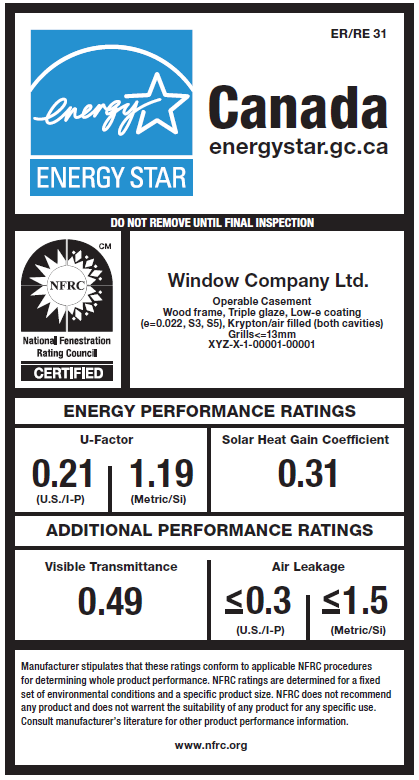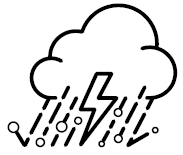Climate ready measures - Windows and doors
Doors and windows play an important role in shielding the interior of your home from the elements. They prevent water leaks, provide fresh air, slow heat loss, reduce solar heat gain, and manage noise.
Windows, doors and skylights account for up to 25% of energy loss in your home. For that reason, energy-efficient windows and doors not only help to reduce our energy bills and keep our homes more comfortable during extreme temperatures, but they also help to reduce our contribution to climate change by reducing the amount of greenhouse gases being emitted.
For more information about choosing energy-efficient models of windows and doors, visit Natural Resources Canada.
-
Download the complete Guide to climate-proof your home.
Window types
New, energy-efficient windows will significantly reduce heat loss and solar heat gain, reducing your annual energy bill. The most efficient Energy Star® certified windows are about 40% more efficient than standard windows.
Natural Resources Canada provides a tool to help you find Energy Star certified products, including windows.

Key properties to look for when purchasing energy efficiency windows
The U-factor measures the rate of heat loss. The lower the U-factor, the slower the heat loss (and the more energy efficient the window). Windows must have a U-factor no greater than 1.22 to be Energy Star certified.
The solar heat gain coefficient (SHGC) measures the amount of solar radiation that passes through a window. The lower the SHGC, the more effective the window is at blocking heat gain from the sun, which can help to keep your home cooler on hot days.
The energy rating (ER) is a measure that includes the U-factor, SHGC, and air leakage. A higher ER indicates a more energy-efficient product. ER values normally range from 0-50. A window must have an ER of 34 or greater to be Energy Star certified.
Double and triple-pane windows have two panes of glass, while triple-pane windows have three. The space between the panes of glass is usually filled with a gas, such as argon, which reduces heat gain and loss through the window. Triple pane windows are better than double pane windows at keeping your home cool in the summer and warm in the winter.
Window materials
Door and window frames are available in a wide variety of materials, including vinyl, wood, fiberglass, aluminum, steel and wood. Consider the following benefits and limitations of each material.
- Windows made from metal are less energy efficient as they conduct heat.
- Metal frames typically cost more than vinyl and fiberglass.
- The sealant products often used for steel or aluminum frames will degrade over time.
- Wood frames are susceptible to moisture uptake and decay.
- Vinyl and fiberglass frames can be formed with air pockets that can be filled with foam to provide extra insulation.
- Fibreglass windows are more durable than vinyl but cost about 10-20% more.
- Hinged, or casement, windows are more air-tight than sliding windows.
- Polymer-based components that make windows and doors weathertight can degrade over time from heat and UV radiation.
- Properly constructed frames of any of these materials are expected to last beyond 25 years.
- Important considerations to ensure the longevity of windows and doors are choosing the materials that best fit your home and climate, and proper installation.
- Replacing your older and inefficient windows will not only result in energy savings over time, but it is also likely to increase the resale value of your home.
- Any material, type or design can include high-efficiency glass and Low-e coatings (a fine metal coating that can reduce heat loss and solar gain by as much as 30%).
Tempered glass windows are required by National Building Code – Alberta Edition where the window area exceeds 0.5 metres squared and is less than 900mm from the floor.
Impact resistant (IR) windows
Impact resistant (IR) windows can be composed of tempered glass or laminated glass.
Tempered glass is heat-treated, which makes it 5-10 times stronger than conventional glass.
If it does break, it shatters into small pebbles without sharp edges, reducing the risk of injury from flying glass.
Laminated glass is made by bonding together two or more panes of glass with a thin layer of film or vinyl in between.
- The laminated plastic acts like fly paper, catching broken glass should the window shatter during a wildfire event, high winds or a hailstorm.
- The outer pane may shatter, but the pieces will hold together. The inner pane should stay intact, preventing rain and water from entering your home.
The strongest glass is only as good as the frame that holds it in place. The window frames holding impact resistant glass are generally thicker than regular residential windows and made from higher-strength materials like aluminum and vinyl.
Impact resistant windows will cost roughly 2-3 times more than standard windows, though they will help manage solar heat gain, improve the energy efficiency of your home and reduce energy bills.
Window films
Window films can be applied to your existing windows and doors to provide a cost-effective solution to climate hazards and other issues. Safety window films:
- make your windows impact resistant and shatterproof, holding glass fragments in place if the window is damaged;
- prevent damage from high winds (and related flying debris) and hail;
- provide protection against intruders, UV rays and solar heat gain; and
- improve privacy.
Before you install window films, consider the following.
- Safety film should be at least 4mm thick.
- Films designed to ONLY reduce solar heat gain are much thinner -
a fraction of 1 mm. - While a reduction in solar heat gain can protect you from the heat in the summer months, it may increase heating costs in winter and increase the need for lighting.
A professionally installed safety film can cost roughly $10-15 per sq ft of window area Film to block solar heat gain is roughly $12-22 per sq. ft. installed.
Window coverings and shading technologies
Shades, screens and blinds can help control solar heat gain in your home. They can be installed inside or outside, on windows, doors, patios and decks.
Interior window coverings
Cellular or honeycomb shades trap air within their core, have excellent thermal properties and provide the added benefit of reducing heat loss in winter months. They also are cost competitive with other internal shading options.
Exterior shading
Exterior roller shades (fabric) or roller shutters (aluminum or plastic slats) will both reduce solar heat gain; roller shutters provide additional protection against other climate hazards (see Window shutters section).
Fixed or retractable awnings can also manage solar heat gain while directing water away from your home. Retractable awnings can be closed to allow solar gain in colder months.
Awnings range considerably in cost, depending on:
- the material (metals costing about 12-15% more);
- whether it is fixed or retractable (retractable costing about 100-200% more); and
- whether retraction is manual or motorized (automated retraction increases costs by about 130-300%)
In general, planting trees and other vegetation to shade your home can be a very effective option for lowering surface and air temperatures on your property and keeping your home cooler. For more details, see the Climate Resilient Tree Planting section within Landscaping and Yard.
Window shutters


External window shutters are a cost-effective solution for multiple climate hazards. Roll shutters:
- reflect heat and prevent heat transfer through the windows (this is more effective than interior blinds);
- are very effective in reducing impacts from wildfire, hail and high winds, preventing the glass from being blown out or debris from hitting and shattering the glass;
- offer a high degree of privacy and security; and
- cost about $30-70 per sq ft installed
Impact and fire-rated doors



Entry doors and your garage door should be impact doors and fire-rated to protect your home against wildfire, high winds, hail or tornados. These doors are made of materials that have been tested and approved to withstand severe weather. Beefed-up door frames and reinforced hinges are used to keep the door in place.
Garage doors are often the home’s weakest component in severe wind. They can be reinforced and laterally braced on either side, especially if there is living space above. Impact resistant garage doors are naturally heavier and may require new springs, track attachments, hinges and rollers.
If you have double entry doors, install a heavy-duty bolt or slide bolt at the top and bottom of the inactive door to resist strong winds.
Weatherproofing and sealing

Weatherproofing – or sealing - your home is an important first step to creating an energy-efficient home. It will make your home cooler during periods of extreme heat and warmer in winter, reducing your energy bills. Weatherproofing windows and window frames also reduces the likelihood of water entry.
Drafts are easy to detect.
- Can you see daylight under doors or around window frames?
- Do your windows rattle in their frames during storms?
- Can you feel air moving against your hand, or do your blinds or curtains move when it is windy?
Consider weatherproofing and sealing if you answered yes to any of the questions above.
There are many guides on how to air seal your home, including Natural Resources Canada’s Keeping the Heat In and the U.S. Department of Energy’s Air Sealing Your Home.
Disclaimer: The content of the Climate Ready Home Guide is for informational purposes only and cannot be construed as technical advice with respect to any particular building(s) or construction project(s). The Climate Ready Home Guide does not recommend or endorse specific products or companies. All products and measures should be installed by a professional contractor, according to manufacturer specifications and following all City Bylaws and codes.

